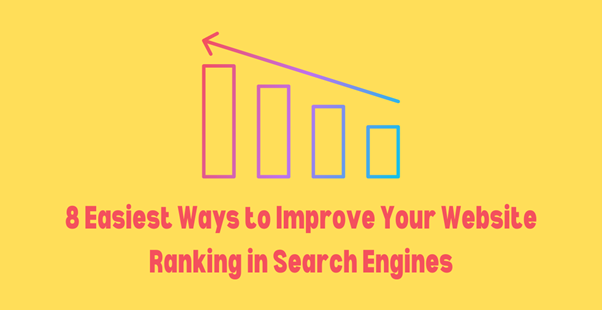Search engines are the lifeblood of any online business. So, if an online business owner wants to make a mark over the web, he needs to increase the ranking of his website ASAP.
But increasing the ranking of a website could be challenging for beginners, which is not surprising though. That’s where this guide of the (eight) 8 easy ways to improve your website ranking in search engines will prove helpful.
After applying the below-discussed eight tips, a blogger or webmaster can make a huge difference to his blog or website. Thus, without any further ado, let’s delve into this discussion.
Here is the list of the 8 Easy Ways to Improve Your Website Ranking in Search Engines.
8 Ways To Improve Your Website Ranking

The following list contains the eight easiest fixes that any webmaster can apply to his website to improve its ranking in search engines.
1. Get an SSL certificate on your server
SSL or Secure Sockets Layer is a digital certificate that forms an encrypted link between a web browser and a web server. This digital certificate enables the website to transfer from HTTP to HTTPS protocol, which is a more secure version.
Thus, if a website still uses the HTTP protocol, it will decrease its user experience because users will have to perform a few additional steps to navigate to that website. This behavior will negatively impact the website’s ranking in search engines, as it gives a privacy error. So, the first easy way to improve your website’s ranking in search engines is to get an SSL certificate.
2. Choose a preferred domain
Having both the ‘HTTPS//’ and the ‘www.’ versions for a website is dangerous for its ranking in search engines because search engines could see a website using both versions as two separate websites.
Doing this will split the link equity coming into a particular website, which means that some of the links will go to the ‘www’ version, whereas the others will go to the ‘HTTPS//’ version. So, neither of them will get the full benefit.
To avoid the split of link equity, a webmaster should choose either the ‘https//yourwebsite.com’ or the ‘https//www.yourdomain.com’ version as the preferred domain style for his website.
*** Pro Tip: If someone wants to change the preferred domain of a non-WordPress website, he will need a developer to edit the ‘.htaccess’ file ***
3. Fix 404 web pages and broken links
404 is a pretty normal error code across the internet, which indicates a web page that doesn’t exist. So, when a webmaster puts the links to a web page that doesn’t exist on his website, the users will face the 404-error code.
This behavior will negatively impact the user experience, which means the ranking of the website will decrease in search engines.
To fix this and improve the ranking of a website facing 404 and broken links issues, webmasters can use automated tools (like Screaming Frog SEO Spider) to find any instances of 404 error codes on their websites.
4. Use permanent redirects
There are a couple of ways to redirect the old link to the new one while moving a web page. For example, a webmaster should use the 301 redirects for permanently moving a web page.
Similarly, a webmaster should use 302 redirects for temporarily moving a web page. However, a webmaster should not use a temporary redirect for permanently moving a web page because doing this will negatively impact the website.
Thus, to increase the ranking of a website in search engines, a webmaster should use permanent redirects.
5. Check your metadata
Search engines like Google look at the page titles first to identify what the page is about and the target keywords for which it should be ranking. Therefore, the metadata of a web page or blog post holds great importance in SEO (Search Engine Optimization). But often, bloggers and webmasters forget to write the meta description. Instead, they publish a page by writing its meta title, which is not a good SEO practice.
Generally, people decide to open a specific web page from SERPs based on its meta title and meta description. So, instead of impacting the SEO, the meta description affects the click-through rate (CTR) of a web page or blog post. Thus, bloggers will find the importance of writing meta descriptions in every how to improve SEO for website guide.
Now, there are a few guidelines when it comes to writing meta titles and meta descriptions. So, let’s see those guidelines before moving on to the next point.
- A content writer should keep the meta title of a web page or blog post under 60 characters.
- A content writer should not forget to include the main keyword in the meta title.
- A good meta description consists of about 155-160 characters.
- A content writer should include the main (target) keyword and 1-2 LSI SEO keywords while writing the meta description of a web page or blog post.
While writing the meta title and meta description, content writers can take help from a rephraser to convert dull words into a fancy and high-end vocabulary.
6. Check your H1 headings
Scanning the H1s of a website with the help of an automated tool will help the users quickly identify the situation of a website from an SEO point of view.
The H1s on each web page should contain the main keyword. Moreover, writers should write H1s according to the topic of the web page. Otherwise, the website will have poor SEO performance. So, for each web page of a website, the content writers should write descriptive headlines.
Additionally, webmasters often use two H1 headings on a single web page, which is another failure from the SEO point of view. Although a web page can include multiple H2 or H3 headings, there should be only one H1 heading style on a web page.
7. Check your sitemap
Most WordPress-based websites already have a sitemap because WordPress bloggers or webmasters create a sitemap through the Yoast SEO plugin. So, to ensure that a particular website will keep on increasing its rank in search engines, the webmasters of that website should check whether the sitemap exists or not. If it exists, does it contain all the main pages?
A sitemap is only essential for large websites. So, if a webmaster has a small business, a sitemap won’t be necessary for such a small website. But it won’t hurt creating a sitemap.
8. Remove links to HTTP pages and HTTP resources
As mentioned earlier in the first point of this (eight) 8 easy ways to improve your website ranking in search engines guide, having an SSL certificate is one of the ways to improve a website’s ranking in search engines. So, if a website has some links to HTTP pages and resources, a webmaster should instantly replace them with HTTPS versions.
Like the other things, webmasters can take the help of SEO ranking checker tools to find and replace HTTP resources and links with HTTPS versions.
Wrapping Up – the Conclusion
Ranking in search engines is a lot easier than many people think. Whether a blogger is just starting or someone is an experienced SEO professional, there are several steps that people can take to improve their website’s ranking in search engines.
But this post covers the eight easiest methods to get a better search ranking for any website. So, read this post thoroughly to apply the above-discussed techniques easily.
Frequently Asked Questions (FAQs)
1. How can I improve my keyword ranking?
Although there are several tips and tricks to improve the keyword ranking for a website or blog, the following are the most basic and easiest ones.
- Use the main keyword in the meta title of a web page or blog post.
- Do not forget to use the main keyword and 1-2 LSI keywords in the meta description of a web page or blog post.
- Understand the importance of LSI (Latent Semantic Indexing) keywords.
- Use a title tag for the page name of a blog post or web page.
- Use the keywords in the alt image tags to also rank your website’s images on search engines.
- Sprinkle the keywords naturally on a web page. Otherwise, Google spider will penalize the blog or website.
2. How do I optimize my website for SEO in 8 simple steps?
Read the above guide to find the eight simplest steps to optimize a website or blog for SEO.
3. What are the 4 major ways to improve ranking on Google’s algorithm?
Google’s ranking algorithm keeps on updating to get better and better. So, according to the latest ranking factors, the following four ranking factors are the most important ones.
- No doubt, SEO is important. But the poor website structure will put the effort of the best SEO campaign in vain. So, a blogger or webmaster should start his blog or website with a sound foundation.
- User experience is one of the key ranking factors of Google’s latest algorithm. So, a blogger or webmaster should work on the user experience of his blog or website.
- Internal linking decreases the bounce rate, which is a positive thing from an SEO perspective. So, a blogger or webmaster should optimize the internal linking on his blog or website.
Before starting to write content, a blogger should understand the intent of its readers. This way, he can produce content according to his reader’s liking, which will positively impact the user experience of his blog.
Read Also:
- 5 Types of Backlinks & Their Role in SEO
- Off-Site SEO: How to Optimize Your Anchor Text Strategy for the Best Results
- Top 5 Common Ecommerce SEO Mistakes & How To Fix Them
Author: Kim Daud
















